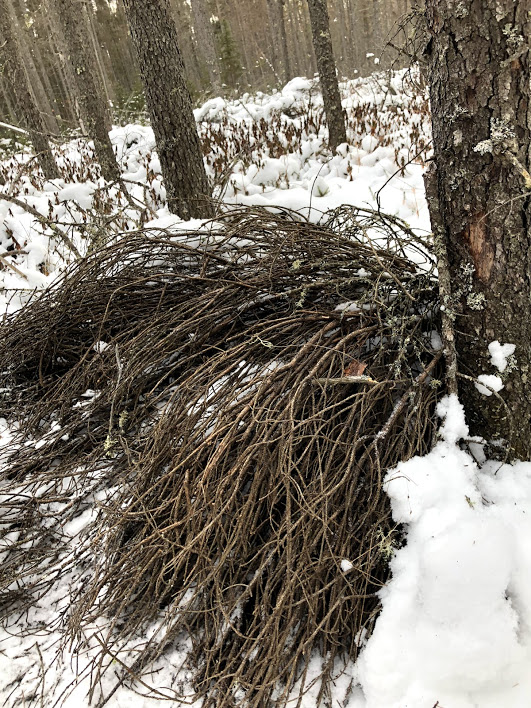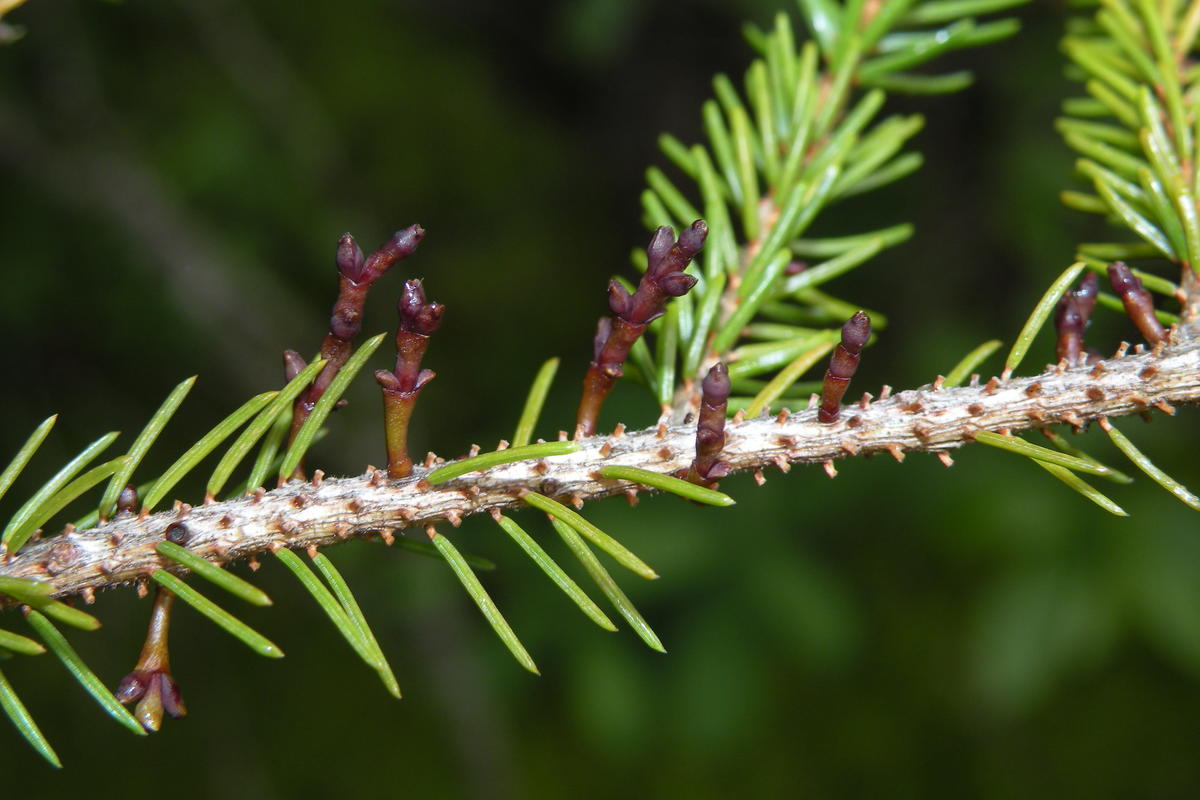Overview

Figure 1: Black spruce stand photo
Many black spruce stands in northern Minnesota are impacted by a parasitic plant called dwarf mistletoe, or Arceuthobium pusillum. This pathogen causes growths to form on infected trees, which decreases the timber yield that is able to be harvested from a site through increased tree mortality. However, not all infected trees show outward signs like growths, so eradicating the pathogen from a stand can prove to be very difficult. A Minnesota DNR policy requires trees taller than 5 feet to be removed from infested sites. The DNR is monitoring a black spruce stand in northern Minnesota post clearcut with some residual trees less than 5 feet in height remaining on the plots.
Silviculture Objective(s)
The impact that residual infected trees have on a regenerating stand is known to be negative. However, the amount of infected residual trees that could be present on a site without causing unacceptable yield losses is unknown. This study’s objective is to seek an answer to this question as well as a question posed by the Department of Natural Resources dwarf mistletoe eradication policy. This policy required the eradication of any tree taller than 5 feet on an infected site, and saw room for improvement in its results. Overall, this study sought to record the changes in the dwarf mistletoe population on this site over a timespan of 30 years.
Pre-treatment stand description and condition
Stand establishment and management history:

Figure 2: A Google Earth satellite view of the greater study area. Much of what is shown on this map is lowlands with B277A and B278A soil series.
This study began with a 38 acre clearcut harvest of 100 year old, dwarf mistletoe infected black spruce in 1961-62. Efforts were made at the time to eliminate all living black spruce within 1 chain length (66 feet) of the visibly infected area.
Pre-treatment species composition:
This stand was comprised primarily of black spruce with some tamarack, northern white cedar, jack pine, and balsam fir also present on the site.
Pre-treatment growth and stocking:
In 1965 there were 1,016 uninfected trees per acre, with around 16 infected trees per acre.
Pre-treatment forest health issues:

Figure 3: Several witches brooms in a dwarf mistletoe-infested black spruce stand elsewhere in northern Minnesota; note this picture is not from the study site. Photo credit Brian Anderson.

Figure 4: Detail of the witches brooms in a dwarf mistletoe-infested black spruce stand elsewhere in northern Minnesota; note this picture is not from the study site. Photo credit Brian Anderson.
This stand was last harvested (in 1961-62) due to a dwarf mistletoe infection occurring at the time. It is likely that the pathogen has been present on the site for some time.
Landowner objectives/situation:
Landowner objectives include understanding how to eradicate dwarf mistletoe and to better understand how it travels. Additionally it is a primary objective to increase knowledge on prevention of dwarf mistletoe infection on a post-harvest site.These objectives work towards the DNR’s goal of reducing timber yield loss within the state of Minnesota.
Silviculture Prescription
Black spruce on site should be reserved as is for further study on the spread of dwarf mistletoe. Natural regeneration and tree mortality will be the main mechanisms for change on site, with dwarf mistletoe playing a large role within the ecosystem.
What actually happened during the treatment
Plots approximately 1.25 acres in size were established in 1966 and were examined in 1969, 1971, 1979, 1988, and 1998. After the initial clearing and plot setup, the stand was left to grow freely and no other treatment was performed. In 1979, brush was removed on plot lines to aid in locating the plot centers and all but one of the center markers were moved, and the center of the unmoved plot had to be estimated using adjacent plots. The reason for the plot centers being moved is not known. All of the trees on one plot died due to extreme flooding, discontinuing its research availability.
During treatment it was difficult to determine which trees were infected as dwarf mistletoe has a long incubation period, and infected trees may not have been recorded as they were not showing symptoms at the time. This was evidenced when a site was not seen to have any infected trees, yet three years later six trees were showing symptoms.
A problem that arose when counting the cumulative number of infected black spruce on the stand is that decay and mortality can occur very quickly. Without tags, it is challenging to know if a current tree is the same as one identified previously. Tagging was not done as the tags could have girdled the spruce or have been chewed on by animals, especially snowshoe hares. It is believed that the cumulative number of infected trees was vastly underestimated.
Post-treatment assessment
Dwarf mistletoe did disappear from two of the plots. One of these plots, when established, had two trees three feet tall and the other plot contained four trees that were one foot tall.
The number of uninfected trees per acre peaked in 1979 and has been slowly decreasing. The infected trees rose from 16 per acre in 1965 to 173 in 1998. On a per-plot basis, 11 plots were infested at the last observation, 8 of which were infested originally.
Plans for future treatments
Once the stand has begun to decline, or when it is aged around 90 - 100 years, a clearcut winter harvest could be prescribed to continue this research on a newly harvested site once again. Due to this being a ponded, peatland site a frozen ground harvest is crucial to ensure the least amount of damage to groundwater movement and soil compaction. However it is recommended that one key change occur in the post-harvesting practice: a prescribed burn should be implemented to lessen the chances of the pathogen surviving on site. Regeneration after harvest would occur naturally.
Costs and economic considerations
The greatest “cost” within this case study is the cost associated with tree mortality and subsequent timber yield loss. According to the 2016 Minnesota Public Stumpage Price Review and Price Indices black spruce sold for $27.02 per cord in 2016. There is an unknown volume of timber on site, but it is likely that much of it will never reach a mill and therefore will not generate revenue. Otherwise, as this stand continues to be studied there will be no great costs until the next clearcut harvest in perhaps 40 - 50 years from now.
Other notes
Featured image included under Creative Commons license, photo credit Doug McGrady, source: www.flickr.com/photos/douglas_mcgrady
This case study was developed with support from the United States Department of Agriculture's National Institute for Food and Agriculture (USDA-NIFA), Renewable Resources Extension Act (RREA). Project #MIN-44-E02, principal investigator Eli Sagor, University of Minnesota.
Summary / lessons learned / additional thoughts
By monitoring dwarf mistletoe in northern Minnesota, the spread and effects of the parasite on previously infected stands that had been clearcut, except for advanced regeneration under five feet, were studied. It was deemed unlikely that the height of the trees left on the site indicates the persistence of dwarf mistletoe, as the site containing two trees over five feet and the seven sites containing a single infected tree one foot tall all had persisting mistletoe infections. Therefore, only eliminating trees taller than five feet does not appear to be adequate to prevent dwarf mistletoe from persisting on the site; dwarf mistletoe was noted to have disappeared on two plots where the max tree height was three feet, however. In addition, dwarf mistletoe was also shown to spread as stands that were not previously infected later contained the parasite.
If done again, there may need to be more effort put into making sure all infected trees are recorded correctly, as there are likely some data errors from difficulties counting. This could be fixed by doing more frequent examinations or finding a less harmful way to tag trees on the plots. Research may also need to be done to study how climate change would impact the spread and mortality of black spruce.
